-
Posts
3,854 -
Joined
-
Last visited
Content Type
Profiles
Forums
Store
Help Articles
Posts posted by hzrt8w
-
-
I am very interested in all the different type of tofu. In the US is more common to eat soft or fried tofu (that I don't like and neither my husband-that is chinese
 ), but on September when we went to visit relatives in Shanghai, the different types of tofu were a revelation to me! There was one in salad, pretty dark, with cilantro and soy sauce...and also another one, always dark, quite hard, very good. Could you explain to me how many tofu there are and how to deal with it.
), but on September when we went to visit relatives in Shanghai, the different types of tofu were a revelation to me! There was one in salad, pretty dark, with cilantro and soy sauce...and also another one, always dark, quite hard, very good. Could you explain to me how many tofu there are and how to deal with it. What you had is "pressed tofu". It is firm tofu that goes through a pressing process to squeeze out most of the water. That's why they are extra hard. They are typically sold marinated with five spice and soy sauce. So the tofu can be eaten as is, or cooked with other ingredients to make a dish.
Indeed there are many types of tofu. They come in all kinds of packaging. But basically there are only a few main types:
Plain (not fried) tofu: Firm, regular, or soft. This refers to the texture softness. Tofu itself tastes very bland. You need to season it with some sauces when you cook it.
Fried tofu: Most of them use regular or firm tofu and deep-fry it to get the brown skin. They sell these in plastic packages (refrigerated) in Asian grocery stores. They are usually used to make some braised dishes with oyster sauce and soy sauce, or cooked with vegetables.
The fried tofo that you have in Chinese restaurants are mostly regular tofu coated in some batter (regular wheat flour and egg, or corn starch, or some kind of flour), deep-fried and served (with light soy sauce typically).
Pressed tofu, as stated above, are firm tofu that have gone through a pressing process to squeeze out the extra water.
Then there is "tofu puff". I am not sure how they are made. They are deep-fried and have many air bubbles inside (very puffy). We usually cut each one in half and stuff it with fish paste, shrimp paste then pan-fried or steamed to make a dish. We also use it to cook vegetarian dishes or fish.
And... there is "tofu fa" (or silken tofu, extra soft tofu). We usually eat it with sugar or ginger-flavored syrup as a dessert or snack.
And, of course, there is "stinky tofu"... but I am not going into that...
 If I don't disturb I have more questions coming
If I don't disturb I have more questions coming
Don't hold back.
 I am sure there are many knowledgeable bodies on this board who can answer your questions.
I am sure there are many knowledgeable bodies on this board who can answer your questions. -
Thanks for the beautiful pictures, jokhm.
They look very scary! ... to a native Hong Konger... too many chilies...
 Do you really eat them all?
Do you really eat them all? -
Hope my ping ying was good enough.
Leo: Welcome to eGullet!
Your ping ying is probably better than most of ours.

-
[...] Hah, this part of the world is a dream for food lovers. People actually think I am here on business...
Are you on a business trip, or leisure? Or a leisure trip disguised as business?


-
Picture:
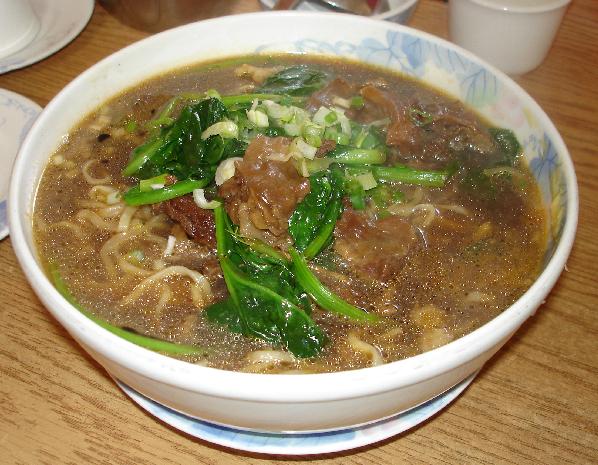
Chinese name: 牛腩麵
English name: Beef Brisket Noodle Soup
Category: Shanghainese noodles
Description: Beef brisket braised in soy sauce mix to perfection. Served on top of wheat noodles in soup.
(Offered at: Shanghai Dumpling Shop, San Francisco, CA, USA)
-
Picture:
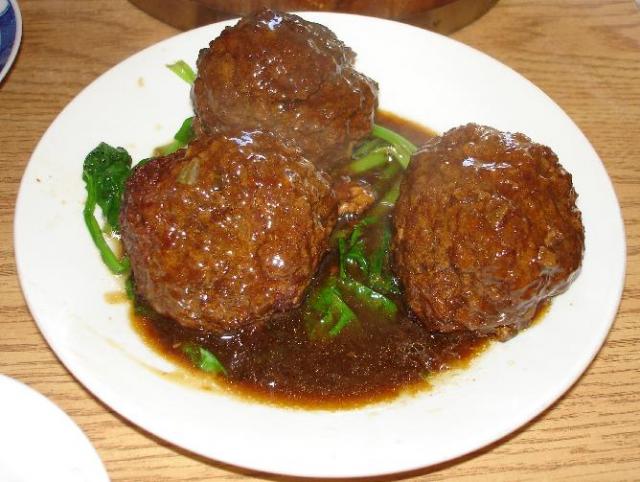
Chinese name: 獅子頭
English name: Lion Head Meatballs
Category: Shanghainese dinner entree
Description: This is a signature Shanghainese specialty dish. Minced pork with seasoning rolled into giant ball shape, first deep-fried then braised in a sauce made with dark soy sauce and other ingredients to perfection. Served on top of some blanched vegetables (typically spinach). The meatballs are very soft, almost "melt in your mouth", and full of flavor.
(Offered at: Shanghai Dumpling Shop, San Francisco, CA, USA)
-
Picture:
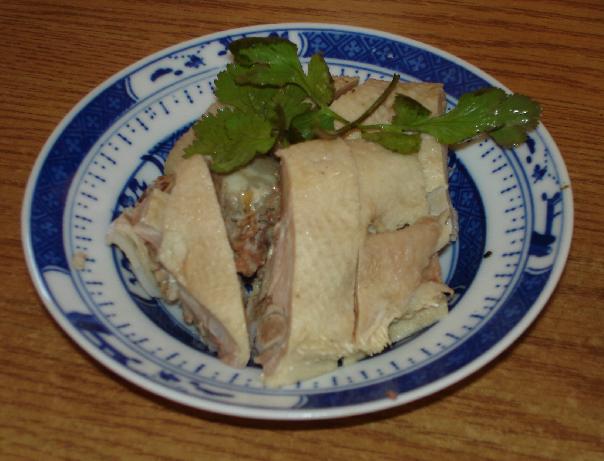
Chinese name: 鹽水鴨
English name: Salt duckCategory: Shanghainese appetizer (cold)
Description: Whole duck marinated and cooked in salt water, then chopped into bite-size pieces. Served at room temperature.
(Offered at: Shanghai Dumpling Shop, San Francisco, CA, USA)
-
Picture:

Chinese name: 燻魚
English name: Smoked fish
Category: Shanghainese appetizer (cold)
Description: Pieces of pomfret marinated with dark soy sauce and other seasoning, smoked to perfection. Sesame seeds are sprinkled on top. Served at room temperature.
(Offered at: Shanghai Dumpling Shop, San Francisco, CA, USA)
-
I did a lot of wandering from Tsim Sha Tsui up to Prince Edward station area. Also here and there closer to the base of the mid-levels elevators. This city is really huge for these short visits of mine. I have been taken to a few notable places in Tsim Sha Tsui east and center, as well as just below Jordan. mmm.
My hotel is the Miramar right on Nathan rd.
I have posted some suggestions to piers who was to stay at Miramar last year like you in this post:
http://forums.egullet.org/index.php?showto...ndpost&p=875627
Also, check out Cha Xiu Bao's website. He is a local. He has many suggestions for good eats. The only challenge is if you can find those places...
I have jotted the following note in some private correspondences since. Hope it may be useful:
Along Canton Road (inside the Ocean Centre and Macro Polo Hong Kong), there are more “upscale” restaurants (some are non-Chinese restaurants such as Thai, steak house, etc.). Maybe more populated with tourists or foreigners. If you go to the Tsimshatsui East area, which is only a 5 to 10 minutes walk from Marco Polo hotel, you will see more Chinese restaurants mostly geared towards locals. There are quite a few Chinese Seafood restaurants in this area. My favorite is (not sure if it’s still there, though I think it is) East Ocean Restaurant. There are others Cantonese Seafood restaurants very closed to each other. Sorry I cannot give you more specifics because I have not been back for 6 years. Hong Kong Cantonese Seafood restaurants typically have a live fish tank at the entrance.
To have seafood: Lee Yu Mun (on Kowloon side, about 5-6 miles away from TST). Sai Kung – which I think has the best seafood. But it is in the New Territories. A bit far. Maybe 10 miles on taxi? And the outlying Island “Cheung Chau”. You need to take a ferry (1 hour ride, plus waiting) there from Central. Terribly inconvenient for just eating dinner. But if you are to make a trip on a ferry, it would be a good ½ day trip. Not sure if you have the time though.
In TST East, if I remember it correctly there is a “Peking House” restaurant specialized in Peking/Szechuan style. They are pretty good. I remember eating a “Begger’s Chicken”… the whole chicken wrapped in lotus leaves and then clay and baked in the oven. And their Peking duck is pretty good too.
On the West side of Canton Road TST, you won’t see a whole lot of restaurants on street level (high rent area). Many of them are inside the office/hotel buildings (e.g. Ocean Centre, Macro Polo Hotel, etc.). If you walk to the East side of Nathan Road (along Cameron Road, Granville Road, Kimberley Road), you will see more Chinese restaurants offer day-to-day local food. You can have some Cantonese wonton noodles in those places and they shouldn’t disappoint. And jook (congee). They are very close to Miramar Hotel.
Around the Temple Street night market, there are quite a few of street-side restaurants/store that offer great food from jook to stir-fries. Those would be the “hole in the wall” places.
There is another “hole on the wall” place that I think you should try. And it is not too far from Miramar Hotel. Walk along Canton Road North til it crosses Haiphong Road (2 minutes). Right turn on Haiphong Road going East. 1 minute. Underneath the overpass of Kowloon Park Drive, there is a place that sells beef balls, fish balls with noodles/rice-noodles. I think eGullet poster “HKDave” mentioned it as well in earlier posts. That would be a really good snack.
Anyway… bear in mind that all my suggestions are from the perspective of a native Hong Konger. Things come easy to me because I grew up there and I speak Cantonese. I would imagine in your case you have added difficulties because of language barrier, and you are a visitor.
Another are where there are plenty of eateries (along the street) is Causeway Bay. It is “the” shopping area on Hong Kong Island (very crowded at night). Take the MTR from Tsimshatsui to Causway Bay (need to transfer once). Go up the exit on Percival. Walk along either Hennesy Road or Lockhart Road. There are plenty of eateries along the street too.
P.S.: Plan a trip to the Victoria Peak. The view is breath-taking. If I can only go to one place in Hong Kong, that’s the one I will visit. You can tour around the Central district during the day. Take the tram up to the peak before sunset. Walk around and enjoy the view. See it turns from day view to night view. The night view is awesome. Then you can take a taxi down to Causeway Bay to have dinner.
-
Picture:
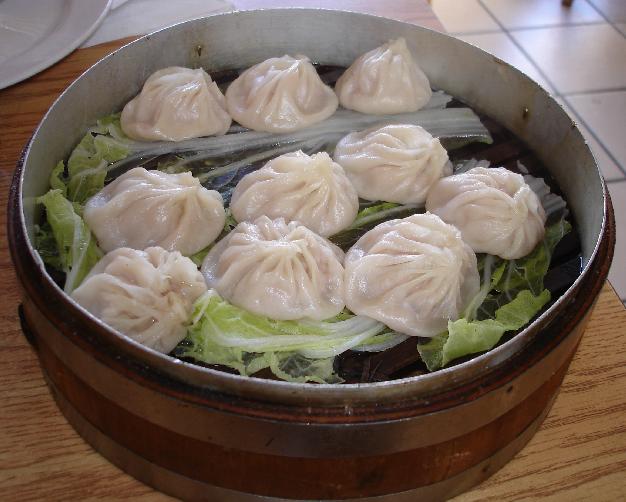
Chinese name: 小籠包
English name:Xiao Long Bao (Shanghai soup dumpling)
Category: Shanghainese entree
Description: Small dumplings with ground pork filling steamed to perfection. The essence is to have the soup (steaming hot) held inside each dumpling. The best made dumplings have very thin wrappers, and are almost transluscent upon serving.
Condiment: Red vinegar with shredded ginger.
(Offered at: Shanghai Dumpling Shop, San Francisco, CA, USA)
-
The following is a series of 5 food pictures taken from a small restaurant called "Shanghai Dumpling Shop" in San Francisco (Richmond district). They specialized in Shanghai style. The food tastes very good.
-
...! I hope someone fills ME in on what is going on with food in HK. I'm just a visitor too.
jokhm: if you have the network bandwidth, check out this thread:
Hong Kong Restaurant Recommendations
Many points have been discussed and argued in the past year.
BTW: Where (what district or area) are you staying in Hong Kong? Where did you have a tendency to wander around? Tsim Sha Tsui? Tsim Sha Tsui East? Central? Wan Chai? Causeway Bay? Or ???
-
[...]One thing I might request is that you include a mention on what these ingredients taste like? Like how oyster sauce is sweet/salty and maybe how it is made if possible? Either way the thread is a great one so thanks once again!
That's a great idea! I will try my best!
Let me go to a time-warp to edit the 5 posts I have written so far to add it in.
-
Is there a sauce or pan gravy or jup that you make from the pan drippings?
The pork chops are already fully flavored.
For those of you who like to "lick the pan", or need to conform with the French cooking technique of "deglazing the pan"... Here is a suggestion:
After removing the pork chops from the pan, dash in 2 tsp of ShaoHsing cooking wine, shed a bit of ground black pepper, and 1/4 to 1/2 cup of chicken broth. Add 1 tsp of dark soy sauce. (Optional: 1 tsp of sugar.) Bring to a boil. Constantly scrap the pan where the shallot/garlic are stuck. Then add some corn starch slurry (suggest 2 tsp corn starch with 2 tsp of water) to thicken the sauce to the right consistency. Pour the sauce on top of the pork chop. Spread on about 1 stalk of chopped green onions on top. Voila!
-
The pic above is of a Vietnamese dish called (in Thai) kung phan oy ("shrimp wrapped around sugar cane"). The actual shrimp is not really sweet, other than what it absorbs from the sugar cane.
In Vietnamese, I think it is called:
Chạo Tôm
The shrimp paste is mixed with a heavy dose of garlic and grilled/BBQed. I love this dish!
-
Picture:
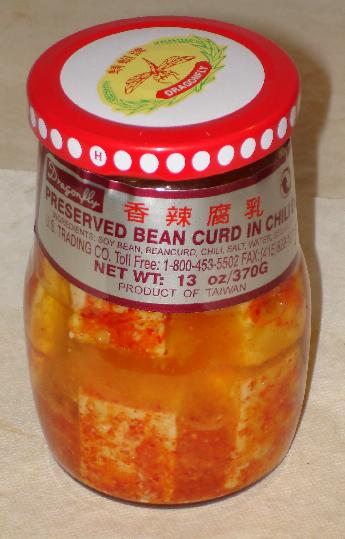
English name: Fermented Bean Curd, or Preserved Bean Curd
Chinese name:腐乳
Chinese pronounciations: (Click here)
Category: Cooking sauce/condiment
Usage: Marination, cooking, condiment
Description: Fermented bean curds (or Fu Yue) are basically tofu (bean curd) that has gone through the fermentation process. They are salty. Some are made with red chilies added. Some are plain. Some call them "Chinese cheese" but this is a misnomer because they are not made from milk, although the texture of fermented bean curds are very close to soft cheese. Fermented bean curds taste very salty.
Where to find it: Asian grocery market, sauce section
Shopping tips: Fermented bean curds are very generic. Most brands taste about the same for the most part but some taste better than the others. It's hard to tell by looking at it. You probably have to try different brands to conclude on the one you like. My favorite brands are "Dragonfly" (shown in this picture) and "Mei Mei". In California, such a bottle typically sells for between US$1.50 and $3.00.
Storage suggestions: Store in the refrigerator once opened.
-
[...] Do you get the PRB gold label soy where you are?i find this really good.
Is this PRB gold a different grade than regular PRB light/dark soy sauce? I don't think I have seen that before (or have paid enough attention to it).
-
Picture:

English name: Dark Soy Sauce
Chinese name:老抽, 醬油
Chinese pronounciations: (Click here)
Category: Cooking sauce, condiment
Usage: Marination, cooking, condiment
Description: Dark soy sauce is another important sauce in Chinese cooking both in Cantonese and other regional styles. You will find it used in most Chinese dishes. Dark soy sauce is rich and more body. It is used in marination, cooking and as a condiment as well. Dark soy sauce tastes salty, and is made from fermented soya beans.
Where to find it: Asian grocery market, sauce section
Shopping tips: My favorite brand is "Pearl River Bridge Brand Superior Dark Soy Sauce" (珠江橋牌 老抽王). This is a very popular brand and should be readily available in many Asian grocery markets. In California, such a bottle typically sells for around US$1.50.
Storage suggestions: Storing in room temperature once opened should be okay, though some prefers to store it in the refrigerator.
-
Picture:
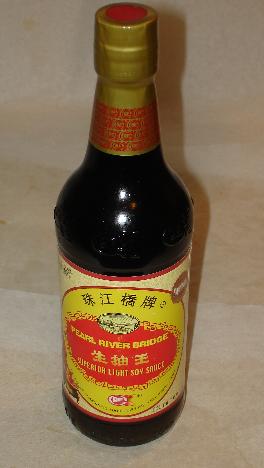
English name: Light Soy Sauce
Chinese name:生抽
Chinese pronounciations: (Click here)
Category: Cooking sauce, condiment
Usage: Marination, cooking, condiment
Description: Light soy sauce is different from dark soy sauce. It is used more in Cantonese style cooking than in northern Chinese style cooking. It is more fluid and a bit saltier. It is used very often in Cantonese seafood dishes. Light soy sauce tastes salty, and is made from fermented soya beans.
Where to find it: Asian grocery market, sauce section
Shopping tips: I have tried many different brands of light soy sauces. Their qualities vary. My favorite brand is "Pearl River Bridge Brand Superior Light Soy Sauce" (珠江橋牌 生抽王). This is a very popular brand and should be readily available in many Asian grocery markets. In California, such a bottle typically sells for around US$1.00.
Storage suggestions: Storing in room temperature once opened should be okay, though some prefers to store it in the refrigerator.
-
Picture:
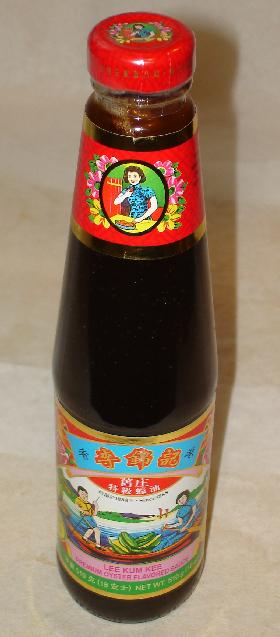
English name: Oyster Flavored Sauce
Chinese name:蠔油
Chinese pronounciation: (Click here)
Category: Cooking sauce
Usage: Marination, cooking, condiment
Description: Oyster flavored sauce (or simply Oyster sauce) is a popular sauce used in Cantonese style cooking. You will find it used in many Cantonese dishes that have a brown color sauce. Often, chicken broth (or other broth) is used with oyster sauce (with corn starch to thicken) to produce the sauce to the right consistency. It is often used to marinate meat, poultry, and add-on when stir-frying. Oyster sauce tastes salty. It is made by steaming fresh oysters to extract their flavor, then adding MSG and food coloring.
Where to find it: Asian grocery market, sauce section
Shopping tips: I have tried many different brands of oyster sauces. Their qualities vary. My favorite brand is "Lee Kum Kee Premium Brand oyster sauce". Note that Lee Kum Kee produces 2 grades of oyster sauces. IMO the premium brand tastes much better, though it costs a bit more. In California, such a bottle typically sells for under US$3.00.
Storage suggestions: Store in the refrigerator once opened.
For more information:
Check out this discussion thread:
-
Picture:

English name: ShaoHsing Cooking Wine
Chinese name: 紹興酒
Chinese pronounciations: (Click here)
Category: Cooking wine
Usage: Marination and cooking
Description: ShaoHsing cooking wine is one of the most important ingredients in Chinese cooking. You will find it used in most Chinese recipes. It is a rice wine, with taste close to Japanese sake. It is often used to marinate meat, poultry, and add-on when stir-frying.
Where to find it: Asian grocery market, wine section
Shopping tips: ShaoHsing (some spells it Xiao Xing) cooking wine is fairly generic, produced by many different manufacturers. Some are of a better grade than others. I would stay away from the super cheap brands. The bottle shown in the picture costs US$6.00.
Storage suggestions: Keep in room temperature.
For more information:
Check out this thread on:
-
I would like to start this thread to post some guides to buying ingredients to cooking Chinese food, such as sauces, fresh produce and dried goods. This is for the benefits of those who are not familiar with Chinese cooking ingredients. Each page will have a picture accompanying with the description of the item, and some tips on where to find them and what to look for, and (if any) my favorite brand.
Feel free to add comments. At some point, I will create an index page for easy references. Over time, we will have a comprehensive list.
-
[...]Oh.. and we overloaded with Indian food in the last two days, and now hoping to find some other veg-friendly places for my friend. He's a Thai nut, but I don't understand how without fish sauce.
I have tried a few Thai restaurants in Ocean Centre as I recall. One example is "Golden Elephant".
I found this page on Vector Map:
-
Lee: Have you been to, during this or past trips, a small restaurant named "Law Fu Kee" in Central? It is blogged in Cha Xiu Bao's webpage:
http://chaxiubao.typepad.com/chaxiubao/200...fish_table.html
Cha Xiu Bao has another update on his blog on "Law Fu Kee" and mudcarp fish ball and wonton just today! I think he is watching our forum!





A pictorial guide to Chinese cooking ingredients
in China: Cooking & Baking
Posted
Yes, dried shrimp comes in many sizes. The general rule is: the bigger the size the more expensive for obvious reasons. As far as which ones are better, I think it is more a personal preference. Theoretically the bigger the size the better. But sometimes they might be a bit hard. I personally like the tiny ones. They seems to be more flavorful and easier to cook. These tiny ones are the size of a dime.